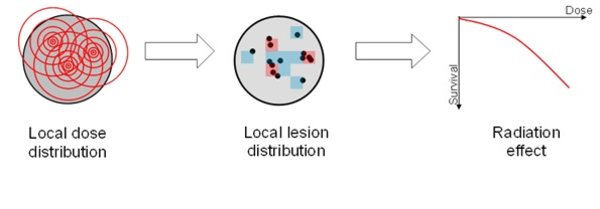Radiobiological Modelling
Group leader: Dr. Thomas Friedrich
Focus of the group is the development and application of mathematical models describing and predicting biologic effects as well as associated uncertainties after exposure to ionizing radiation. Working models are the Local Effect Model (LEM) to describe the effectiveness of ion radiation, and the Giant Loop Binary Lesion (GLOBLE) model as a general mechanistic dose response model. The LEM model is currently used in the treatment plan systems for heavy ion therapy in Europe. The GLOBLE model is gaining increasing importance in describing dose response data in radiobiology. Both models are based on the notion of the spatial distribution of lesions to the DNA on different spatial scales and allow to interpret and predict a wide range of phenomena and endpoints in radiobiology, radioprotection and clinical applications.
Main research topics
- Understanding and predicting the relative biological effectiveness (RBE) of ion radiation at all energies [1-3]
- Validation of biological models at hand of experimental and clinical data; development and maintenance of in-vitro cell survival data base for this purpose (see PIDE project) [4]
- Spatial characteristics of radiation damage patterns: Ionization densities, DNA lesion distribution (biological manifestation of track structure), clustered lesions and formation of complex damage on different spatial scales [2,3,5,6]; impact on lesion processing and repair [7]
- Impact of temporal aspects of dose delivery, lesion processing and repair on the effect [8]
- Use of predictive models in treatment planning systems for particle therapy of cancer [9,10]
- Cell cycle effects of radiation damage [11]
- Modelling carcinogenic potential of ion radiation [12]
Collaborations
- HIT / DKFZ Heidelberg (O. Jäkel)
- DKFZ Heidelberg (C. Karger, P. Peschke)
- HMGU München (W. Friedland)
- TU München (T. Schmid)
- Universität der Bundeswehr, München (G. Dollinger)
- TU Darmstadt (M. Löbrich)
- Universitätsklinikum Erlangen (C. Bert)
- Louisiana State University, LA, USA (W. Newhauser)
- University of Maryland, MD, USA (J. Eley)
- MGH, Boston, MA, USA (H. Paganetti)
- Universitätsklinikum Gießen-Marburg (K. Zink / R. Engenhart-Cabillic)
- MD Anderson Cancer Center, Houston, TX, USA (R. Mohan and D. Grosshans)
- National Institute of Radiological Sciences, Chiba, Japan (Y. Furusawa)
- Raysearch Ltd., Sweden (Industry Collaboration)
PIDE Project
Selected Publications
- Eley et al., Int. J. Radiat. Oncol. Biol. Phys. 95, 279 (2016)
- Friedrich et al., Radiat. Prot. Dosim.166, 61 (2015)
- Hufnagl et al., DNA Repair 27, 28 (2015)
- Friedrich et al., Radiat. Res.181, 485 (2014)
- Herr et al., PLoS One9, e83923 (2014)
- Tommasino et al., Radiat. Res. 180, 524 (2013)
- Friedrich et al., J. Radiat. Res. 54, 494 (2013)
- Friedrich et al., Radiat. Res.178, 385 (2012)
- Friedrich et al., Int. J. Radiat. Biol. 88, 03 (2012)
- Grün et al., Phys. Med. Biol. 57, 7261 (2012)
- Elsässer et al., Int. J. Radiat. Oncol. Biol. Phys. 78, 1177 (2010)
- Krämer and Scholz, Phys. Med. Biol. 45, 3319 (2000)
- Scholz et al., Radiat. Environ. Biophys. 36, 59 (1997)





